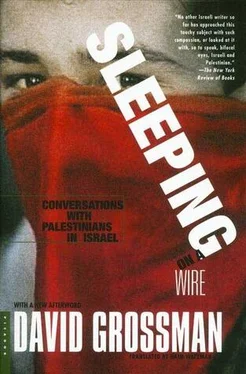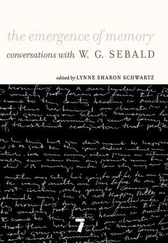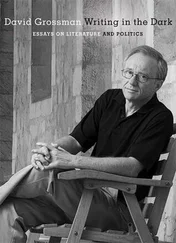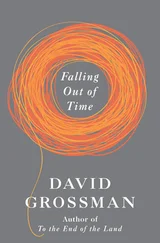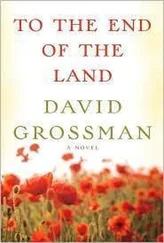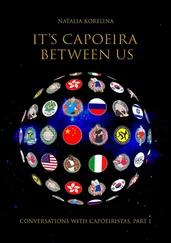My thoughts kept turning to the old man in the white robe. What right had I to criticize him? From what experience could I judge him, and what hand did I — as part of the Jewish majority — extend to him to prove that he can now be free of his caution and his artifice? After all, it is again, always, the same strong, warning hand.
The Jezreel Valley, which the Arabs call Marj Ibn Amer, stretched out from both sides of the road. These are Iksal’s fields, which now belong to the Jewish village of Tel Adashim and which the old man worked in his youth. He passes by them every day and sees others working them now. Everything has changed before his eyes, the view is no longer his, the names are no longer his; his homeland has been translated. I put myself in his place, as a young man standing between the defeat of his nation and the new Israelis, and afterward, as mukhtar , between his villagers and the military governor; and now, faced with the intifadah, faced with extremists, faced with the piercing eyes of his grandson, facing the old age that weighs on his shoulders. All the while between the two lines of the gauntlet.
Asem! Aaaaasem!
With all that my lungs can muster. Hands cupped to my mouth: Aaaasem!
The echo bounces back at me from the mountains all around. The pines nod in commiseration. The car, its maw gaping wide, shoots up a jet of thick vapor. Aaaaasem…
He said he would meet me at nine under the carob tree. Maybe I got the hour wrong. Maybe I got the carob wrong. The directions I received by telephone said that in the forest there is a road to the village. So I drove into the forest, and now I have been wandering around and losing my way for almost an hour. Somewhere in the heart of this wood there is a village that does not exist, and in the village people I was going to visit because they do not exist. Many are the roads that lead to this invisible village, and my Peugeot, which is no longer young, is jolted and thrown from rivulet to pothole, from rock to hard place.
There must be another way. I collapse on a boulder in the forest and try to gather together the senses scattered by the twists and turns. This could not possibly be the road to the village. Because if people live there, even people who do not exist, there has to be one tolerable road for them to come and go by.
Suddenly a voice calls my name. Who’s calling? From where? Is it Asem? Hard to know. The echoes roll in from all sides. Someone heard my cries and he is calling me. Maybe not me? I shout again. Wait a moment, for the echoes to fade out. The man makes a sound. But there can be no real conversation in this seashell of a forest. The words run into each other, I don’t even know what direction they’re coming from. Again I call out, trying to convey also in the brief name Asem my request that they come rescue me, and my anger at the labyrinth and the bad directions, and I consider, between shout and echo, that even in such a small country as Israel it is enough to step off one’s familiar route to be sucked into the absurd.
The other man continues to call me. I have already begun to enjoy the game a bit. Maybe he has, too. Together we were learning to separate the information from its repercussions. I have an opportunity to hear how he hears the overreverberation of my plight, and how our oversized echoes crash and hammer each other so far from either of us. Almost at the same moment we both understand that in order to hear the other, and to succeed in the delicate effort of bringing our positions closer, we must make our shouts much fewer and briefer; then, suddenly, additional voices join in, maybe forest workers laboring on one of the hills between him and me. They see both of us but are themselves unseen. They mediate between us, direct us to each other. I involuntarily recalled the legends I had heard about the people of this village — that they appear suddenly in a house once theirs, that sometimes you open your door unsuspecting and there they sit in the doorway, and when they see you they rise slowly and leave.
After long minutes of mutual echoing, there is a flurry and rustle in the bushes. Someone is running. A boy is running. We meet. He is covered with sweat. He ran two kilometers through the forest to find me. Asem? No, his cousin. He heard me calling, saw the car, and understood I was in distress. And where is Asem? Went to work. Am I a friend of Asem’s? What have I come for? Here, let’s drive to our place in the village, you’ll wait for him there. He’ll be home soon. When is soon? Right now. Noontime. One o’clock.
It is now eleven.
Parched in spirit, I slam shut the Peugeot’s gaping door. The boy — his name is Jaber — indicates a road, but it is so steep, so full of boulders and holes, that the car cannot withstand it. The motor dies time after time. We choose another way. Three times longer and twisting. We twist with it, we triumph, and in a cloud of dust we finally enter the village of Ein Hud.
A tiny village. Thirty-three houses all told. Built on the mountainside, completely hidden by the trees. One hundred and sixty people live here, present absentees.
What follows is a brief legal explanation, for good hikers.
An absentee, according to Absentee Property Law 5710–1950 (1), is every person who was, after the United Nations partition decision in November 1947, a citizen of an enemy country, or who moved into enemy territory, or who was a citizen of the British mandate and left his or her regular place of residence for a location outside Palestine before September 1, 1948, or who left for a “location in the Land of Israel that was controlled at that time by forces that wished to prevent the establishment of the State of Israel, or which fought it after its establishment.” Such a person was considered an absentee from that date, and his or her property and land were transferred to the ownership of the Custodian of Absentee Property.
There are, however, absentees who are, like it or not, present; their land and property were taken, but they themselves live with us, in our country, and the legal and existential category of “present absentees” was created especially for them.
For instance, the Arabs of the Little Triangle — a patch of territory between Jerusalem and Haifa, including the Wadi Ara road connecting the coast with the Jezreel Valley — were annexed to Israel as part of the Rhodes armistice agreements of 1949. Ever since, they have been citizens, but their land and property that remained in Israel after November 1948 had already been confiscated by the state and they themselves became present absentees. The same with Arabs, such as the people of Ein Hud, who abandoned their houses during battles and were not found there on the date that the general census was held. They, too, instantaneously became present absentees. (Every time I write that pair of words I can’t help imagining the shiver of delight that must have run through the entrails of the bureaucratic octopus when the term was first ejaculated in clerical ink. Interesting — who coined that combination? Did he act alone, or did an entire company of chalky perukes sit in intense deliberation until this dicotyledon suddenly spawned?)
No one really knows for sure how many present absentees there are in Israel. In 1949 they numbered 81,000 individuals among the approximately 160,000 Arab residents of Israel. They included Muslims, Christians, and Bedouin. Many of them found new places to live, not on their own land, and there they receive the services that the state grants its citizens — that is, they are considered absentee with regard to their property and present with regard to their citizenship.
An enormous amount of property is involved — almost 400 abandoned villages, with their houses and land (more than 3 million dunams, some 750,000 acres); more than 25,000 homes in urban centers, close to 11,000 stores and workshops, as well as movable property, bank deposits, art objects, and stock shares. All these were “absentized” by the law.
Читать дальше
